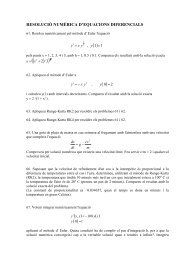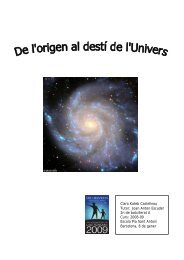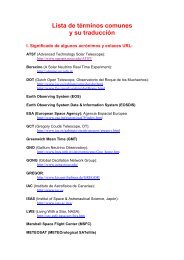Universitat de - Departament d'Astronomia i Meteorologia ...
Universitat de - Departament d'Astronomia i Meteorologia ...
Universitat de - Departament d'Astronomia i Meteorologia ...
You also want an ePaper? Increase the reach of your titles
YUMPU automatically turns print PDFs into web optimized ePapers that Google loves.
4 Chapter 1. Introduction and background<br />
• Be stars: B or late O stars with luminosity classes III–V with emission lines,<br />
indicative of an equatorial <strong>de</strong>cretion disk. Masses in the range ∼ 8–20 M⊙.<br />
Orbital periods in the range ∼ 10–250 days, with eccentricities 0.3. Do not<br />
fill their Roche lobe, and accretion onto the compact object is produced via<br />
mass transfer through the <strong>de</strong>cretion disk. Most of these systems are transient<br />
X-ray sources during periastron passage. The compact object is typically a<br />
strong magnetic field neutron star, and most of these systems are X-ray pulsars.<br />
The lifetime of Be/X-ray binaries is around ∼ 10 7 years.<br />
• OB SG stars: O or B stars with luminosity classes I–III. Masses above 15 M⊙.<br />
Orbital periods typically below 10 days, with eccentricities 0. The mass<br />
transfer is due to a strong stellar wind and/or Roche lobe overflow, with mass<br />
loss rates up to 6 × 10 −6 M⊙ yr −1 . The X-ray emission is persistent, and<br />
large variability is usual. The lifetime of SG/X-ray binaries is between ∼ 10 5 –<br />
10 6 years.<br />
The typical X-ray to optical luminosity ratio is in the range LX/Lopt 10 −3 –10,<br />
although highly absorbed systems in the optical have higher values.<br />
The most recent catalog of HMXBs was compiled by Liu et al. (2000), and<br />
contains 130 sources. We have ad<strong>de</strong>d to this catalog a source previously classified<br />
as a LMXB. We show in Fig. 1.1 the distribution of catalogued HMXBs in galactic<br />
coordinates. As can be seen, these systems are located close to the galactic plane (in<br />
or near spiral arms) because are young stellar systems of Population I. The presence<br />
of HMXBs in the Small and Large Magellanic Clouds (SMC and LMC) is also clearly<br />
seen.<br />
In Table 1.1 we list the number of different types of HMXBs within the SMC,<br />
the LMC, the Galaxy and total values. In the Be and SG types we have consi<strong>de</strong>red<br />
all the confirmed cases and also the suspected ones based on X-ray properties or<br />
orbital solutions. NF stands for those sources that do not fit in the Be or SG types.<br />
Un<strong>de</strong>r the question mark we list the number of sources without a clear i<strong>de</strong>ntification<br />
or with a suspected white dwarf (WD) compact object. All of them amount to 131<br />
systems, of which some are X-ray Pulsars (XPs) and/or transient sources, as quoted<br />
also in the table. Finally, the number of Radio Emitting X-ray Binaries (REXBs)<br />
has also been inclu<strong>de</strong>d (see Sect. 1.1.3).






